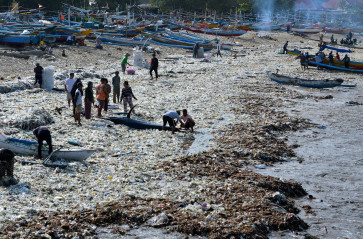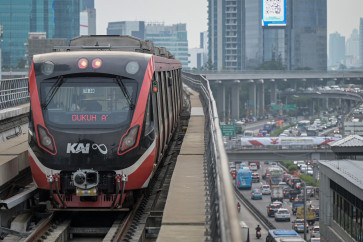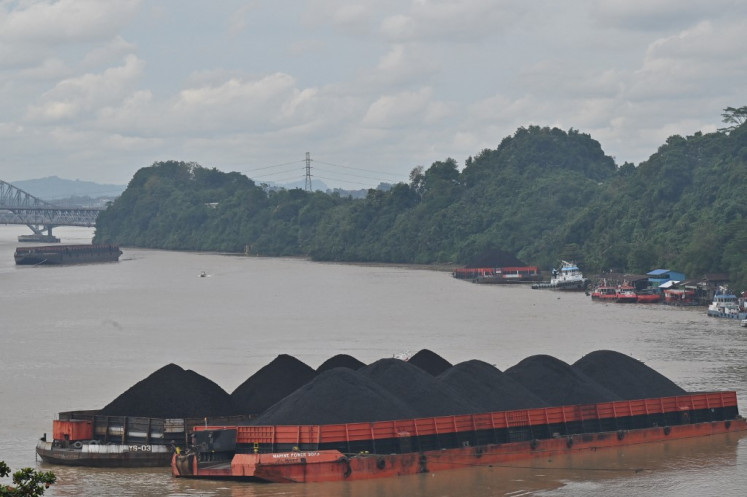Fighting militarization of South China Sea
The time has come for the 10 leaders of the 50-year-old ASEAN to unite on the issue of a legally binding code of conduct (CoC) over the South China Sea, and strongly oppose the militarization of the disputed area
Change text size
Gift Premium Articles
to Anyone

T
he time has come for the 10 leaders of the 50-year-old ASEAN to unite on the issue of a legally binding code of conduct (CoC) over the South China Sea, and strongly oppose the militarization of the disputed area.
ASEAN leaders are scheduled to meet in Clark, the Philippines, for the 31st ASEAN Summit and related meetings on Nov. 13 to 15.
More than 600 million people in Southeast Asia are eagerly waiting for the possible outcome of the ASEAN Summit on contentious issues like the South China Sea, ASEAN unity, terrorism, North Korea and Regional Comprehensive Economic Partnership (RCEP) trade talks and climate change.
ASEAN member states like Vietnam, the Philippines, Malaysia and Brunei have overlapping claims with China and Taiwan to certain parts of the South China Sea, which has a maritime area of 3.5 million square kilometers.
But China claims more than 80 percent of the resource-rich South China Sea based on so-called “historical grounds,” as well as a controversial cow-tongue-shaped “nine-dash” demarcation line. This line, the mother of all conflicts and controversies, also encroaches into a part of Indonesia’s Natuna maritime area, though the archipelagic state is not a claimant in the dispute.
Among all the issues that ASEAN is currently facing, the South China Sea is an important one that of late has become the single biggest threat to ASEAN unity, peace and stability due to China’s assertiveness and militarization of the area.
Using “coercive” methods, China — which is determined to take more than 80 percent of the South China Sea maritime area by any means, including military action — has built numerous artificial islands through reclamation in recent years.
Now it is turning them into military bases by building military facilities and deploying heavy weapons.
However, China denied recently that it was militarizing the South China Sea.
Yao Wen, a councilor at the Asian affairs department of China’s Foreign Ministry, told Asian journalists recently in Beijing that China had no plans for militarization.
“China will never seek [to militarize] the South China Sea,” Yao said, adding that China had indeed built some structures, like lighthouses and hospitals, on reclaimed reefs and islands.
Chinese actions in the South China Sea are raising concerns all over the world. Both claimant and non-claimant countries, including the United States, India, the United Kingdom and Japan, believe that many of Beijing’s unilateral actions pose a serious threat to regional peace, security, freedom of navigation, overflight and legal fishing.
Given the potential danger of the situation, what can ASEAN do?
First, the unity of ASEAN is important and all member states must work hard to maintain ASEAN’s centrality in all regional issues and security mechanisms, and prevent war at any cost.
“Unity and centrality must be nurtured,” Foreign Minister Retno LP Marsudi said recently in Jakarta.
Second, ASEAN must stick to its principle that all South China Sea disputes must be resolved through peaceful means based on international law.
Third, ASEAN must demand China to honor the Permanent Court of Arbitration’s (PCA) ruling on the South China Sea issue.
The Philippines took China to international arbitration in 2013 over the latter’s blockade of the Scarborough Shoal, which is located within the Philippines’ Exclusive Economic Zone (EEZ).
In July 2016, in a landmark decision, the PCA clearly ruled that China had no historic title over the waters of the South China Sea because China had signed and ratified the United Nations Convention on the Law of the Sea (UNCLOS).
Many countries have asked China to implement the PCA’s ruling as it is legally binding, but Beijing, which boycotted the court hearings, continues to reject the ruling. Nevertheless, this was a major blow to Beijing’s international standing.
After the major loss at the PCA, China is now putting forward the “Four Sha” (Four Sands) claim in place of the controversial nine-dash line maritime claim. Four Sha refers to four island groups, namely the Paracels, Spratlys, Macclesfield Bank and Pratas, which are respectively called Dongsha, Xisha, Nansha and Zongsha in Chinese.
The Four Sha claim is based on the straight baselines around the four island groups. Though it is a clever legal tactic compared to that of the weaker nine-dash line, the claim clearly violates Articles 46 and 47 of UNCLOS.
Fourth, ASEAN must achieve a consensus on the issue of a legally binding CoC and negotiate with China. The common ASEAN position will facilitate the negotiations.
Recently, in a positive development, China has agreed to a framework agreement on the CoC with ASEAN, but these negotiations should not take a long time. The delay in a CoC will only benefit China.
Some people may question whether ASEAN can unite under a CoC, given the deep divisions and some member countries’ close links with China.
Last month, all ASEAN defense ministers strongly condemned the Islamic State’s (IS) terror activities in the Philippine city of Marawi — where more than 1,000 people were killed — and supported the Philippines’ efforts to curb terrorism. That is the spirit of the ASEAN family.
Likewise, ASEAN member states can unite on the South China Sea dilemma, which affects five ASEAN member states, including Indonesia. It is the time for ASEAN to work like a family and take a common position on the South China Sea disputes.
Indonesia, the de facto leader of ASEAN, does not recognize China’s nine-dash claim. In line with UNCLOS and the aftermath of the PCA ruling, Indonesia recently renamed some parts of the South China Sea the North Natuna Sea, which led to a strong protest from China.
Countries like Indonesia and Vietnam, the second biggest claimant of the South China Sea after China, must work together to convince other ASEAN member states to stand firmly against China’s assertiveness and coerciveness on the matter.
Last month’s 11th ASEAN Defense Ministers’ Meeting (ADMM) in Clark sent some positive signals about a united ASEAN. The ADMM called for peace and stability in Southeast Asia, as well as freedom of navigation in the South China Sea.
“[The declaration is] emphasizing the commitment of all parties to fully and effectively implement the [Declaration on the Conduct of Parties over the South China Sea], ASEAN’s Six-Point Principles on the South China Sea and reiterating the importance of expeditiously working toward an early conclusion of the Code of Conduct in the South China Sea,” said the ADMM’s joint declaration.
The world is watching whether during their summit, ASEAN leaders will underscore the unity their defense ministers had displayed.
__________________________________
The author is a staff writer with The Jakarta Post.









